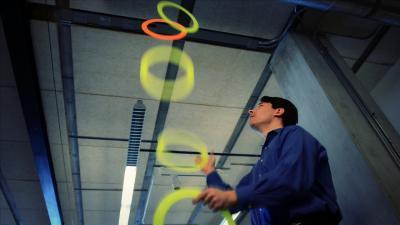Juggling may seem like mere entertainment, but a study led by Johns Hopkins engineers used this circus skill to gather critical clues about how vision and the sense of touch help control the way humans and animals move their limbs in a repetitive way, such as in running. The findings eventually may aid in the treatment of people with neurological diseases and could lead to prosthetic limbs and robots that move more efficiently.
The study was published online recently by the Journal of Neurophysiology and will be the cover article in the journal's March 2014 print edition.
In their paper, the team led by Johns Hopkins researchers detailed the unusual jump from juggling for fun to serious science. Jugglers, they explained, rely on repeated rhythmic motions to keep multiple balls aloft. Similar forms of rhythmic movement are also common in the animal world, where effective locomotion is equally important to a swift-moving gazelle and to the cheetah that's chasing it.
"It turns out that the art of juggling provides an interesting window into many of the same questions that you try to answer when you study forms of locomotion, such as walking or running," said Noah Cowan, an associate professor of mechanical engineering who supervised the research. "In our study, we had participants stand still and use their hands in a rhythmic way. It's very much like watching them move their feet as they run. But we used juggling as a model for rhythmic motor coordination because it's a simpler system to study."
Specifically, Cowan and his colleagues wanted to look at how the brain uses vision and the sense of touch to control this type of behavior. To do so, they set up a simple virtual juggling scenario. Participants held a real-world paddle connected to a computer and were told to bounce an on-screen ball repeatedly up to a target area between two lines, also drawn on the monitor. In some trials, the participants had only their vision to guide them. In others experiments, whenever the digital ball hit the onscreen paddle the participants also received a brief impulse on their real-world paddle. This mimicked the sensation they would feel if a real ball had actually struck the paddle they were holding.

Engineers led by amateur juggler Noah Cowan studied a juggling task to learn how the sense of touch contributes to rhythmic movement such as running.
(Photo Credit: Photo : Johns Hopkins University)
With the added touch sensation, also called haptic feedback, the participants made about half as many errors in the task, the researchers reported.
"We have a pretty good understanding as to why," said Cowan, who has been an amateur juggler since middle school. "One of the tricky challenges in juggling is catching a rhythm; that is, getting yourself entrained with the movement of the ball. It's about timing your own action with the action in the environment. When you get the pulse of haptic feedback at the exact moment the ball hits the paddle, it give you a precise sense of the timing for the juggling pattern that you're trying to achieve."
Added M. Mert Ankarali, a Johns Hopkins mechanical engineering doctoral student who was lead author of the study: "The human nervous system gets feedback all of the time from our sense of vision. But the important thing about the sense of touch while juggling is that we get a precise timing cue that complements the continuous visual feedback. This timing cue is very important for us to get the rhythm of the juggling task."
A more surprising discovery was that adding the touch feedback didn't seem to improve the participants' ability to correct for any juggling errors they made while trying to hit the ball into the target zone. But it did enable them to make fewer errors overall. "The haptic sensation is just a tiny bit of feedback that's provided once per juggling cycle," Cowan said. "Yet that tiny bit of information seems to be critical for people to improve their juggling performance. We think that's because while vision provides excellent spatial and positioning information, the haptic information provides very important timing information."
When humans and animals walk or run, Cowan added, their sense of touch plays a key role: As the runner's feet touch the ground, they alert the nervous system to adjust the movement of the legs to accommodate changes in the running surface. He also noted that the brain's ability to instantly integrate information coming from both the eyes and the sense of touch is a critical part of successful running, juggling and other repetitive movements.
The researchers say that future studies of the connection between sensory feedback, timing and limb movements could help clinicians to better understand how some neurological diseases such as sensory ataxia might disrupt the brain's timing of movements by arms and legs. Future findings may also assist engineers who are trying to make touch-sensitive artificial limbs and robots that move as skillfully as animals in the wild.




Comments